
Rafinesque, Bulletin Botanique 1: 216, 1830
(Also see Opuntia mesacantha Raf ssp mesacantha Majure, Phytotaxa 290, 1: 1–65)
See O. cespitosa See O. humifusa See O. lata
Neotype; Herbarium; Herbarium; Herbarium; Hebarium (as O. humifusa); Herbarium; Herbarium; Herbarium; Herbarium; Herbarium; Herbarium
Original Description
What is Opuntia mesacantha?
Opuntia mesacantha is a southeastern pricklypear found in Mississippi, Alabama, Georgia, Florida, South Carolina, and North Carolina, on the Atlantic Coastal Plain and the Barrier Islands. It is absent in the Florida peninsula. It resembles O. humifusa, O. lata, and O. cespitosa but has distinct differences.
Details
O. mesacantha is a prostrate plant that may branch in all directions to 1 m across. Cladodes may be spined or unspined and are smooth in outline, obovate or rotund, occasionally elliptical. Spines are stout (0.95-1.3 mm in diameter).
Flowers are pure yellow with no red. Fruits are reddish at maturity. Seeds are 5.0-5.9 mm long.
ike other eastern pricklypears, O. mesacantha colonizes sandy or rocky areas that become dry between rains.
Opuntia mesacantha is tetraploid.
Other Notes
Concerning the differences between O. mesacantha and O. humifusa, The Flora of the Southern and Mid-Atlantic States (2015) reports:
O. humifusa is an allotetraploid (2n=44), cryptic species that is most easily confused with O. mesacantha ssp. mesacantha, from which it can be separated by its lack of spines…and generally increased number of areoles per diagonal row across the cladode face at midstem (4-5 vs. 3-4 in O. mesacantha), generally inserted glochids (vs. exerted in O. mesacantha), and smaller seeds (4.0-4.6 mm long in O. humifusa vs. 5.0-5.9 mm long in O. mesacantha) with a smooth funicular envelop (instead of the upraised funicular envelope in O. mesacantha ssp. mesacantha).
For more information, see:
Majure, 2014, and Majure et al, 2012.
Adanick et al., 2020, developed a method to measure stomates (size and distance from each other) in the field to differentiate O. mesacantha and O. lata.


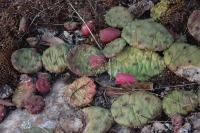

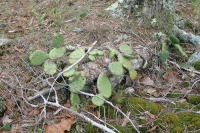
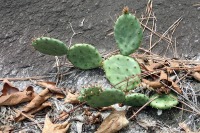
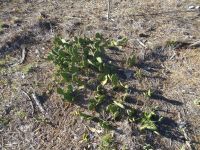



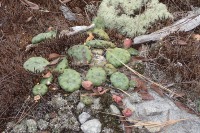
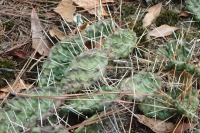
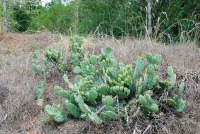

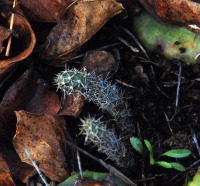


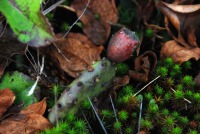




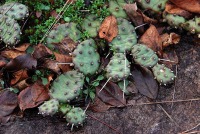





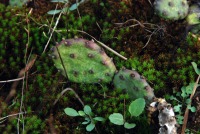
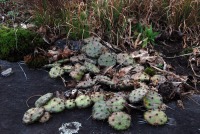

dear team,
thank you for creating this wonderfully elaborate website.
This is my go to place for my daily fix. Great work.
I have a question for you.
I have a plant that was bought by me some 30 years ago as Opuntia humifusa.
I now have (based on your expert details) some issues with this name for this particular specimen:
-It has only 3 areolas on the diagonal of even the largest pads.
-It forms thickened roots at the base of the plant (15 to 20 mm thick).
-The flowers are yellow and the plant forms no spines.
-Glochides are grayish brown.
-Shape and color of the cladods would fit O. humifusa however (new) pads are not glabrous.
Are there known plants of O. meascantha that form thickened roots or do you have any other suggestions?
I know from Backenberg that O.lata is known to have thickened roots however my plant is fully prostrate in winter and the cladods are not scalloped at all.
Looking forward to your reply.
Hi,
Thanks for visiting our website.
First, I don’t count areoles to determine a species. But. O. humifusa can easily have 3 or 4 across a pad.
Second, it is hard to know about the thickened roots. After 30 years almost any Opuntia will have thick roots.
Yellow flowers suggest O. humifusa, O. mesacantha, or O. lata.
The winter form (prostrate) occurs in all three but is very pronounced in O. humifusa.
Just from your description, I think it might be O. humifusa.
You can email a few pictures to me and Dave at jshaw@opuntiads.coom and davef@opuntiads.com. We might have a more solid guess if we saw pictures.
Joe
Ive been looking sooo long for O. Mesacantha, It really has been a search. I live in Alabama so I know that it’s here, I go into the woods anytime I can to try and find any but I never do, is the O. Mesacantha variety dying out?
Hi,
Thanks for visiting our website.
O. mesacantha is not dying out. But, it does occur sporadically and perhaps in smallish colonies. I will send you contact info for someone who might be able to help you.
Joe